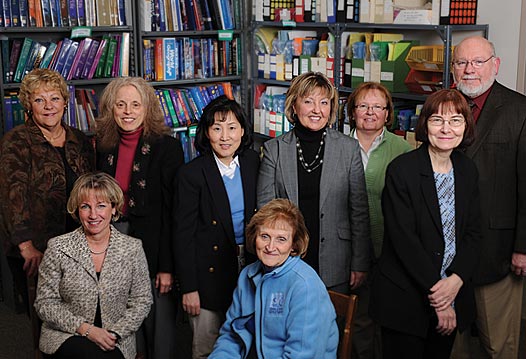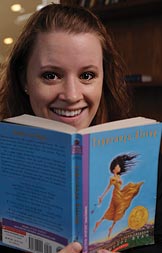The sixth in a six-part series on the College's nationally accredited programs.
Theory to Practice
By Natalie Davis Miller

Saint Mary’s Education Department, full-time faculty and staff (standing, left to right): Professor Catherine (Kitty) Green, Director of the Learning Tree Jayne Fogle, Professors Insook Chung, Mary Ann Traxler, Director of Student Teaching Karen Van Meter, Loretta Li, and Dale Banks; (seated): Professor Nancy Turner, and Administrative Assistant Mary Moen.
The word is out. Graduates of Saint Mary’s Education Program are highly sought after.
Recruiters from outside the state have been known to contact the department in search of teachers, according to Dale Banks, chair and licensing advisor of the Education Department at Saint Mary’s College. Banks is proud of the program’s notoriety and says it’s well earned. “We have a good reputation; we produce a teacher who is prepared to walk into a classroom and carry out all the necessary things for those kids to get a good education.”
The education department is one of Saint Mary’s six nationally accredited programs, receiving accreditation through the National Council for Accreditation of Teacher Education (NCATE). The department offers an elementary education major, and students completing the major, along with passing national tests, are licensed to teach in primary and intermediate schools. In the fall of 2008, the department will also offer an elementary education major with a Certificate in Special Education: Mild Intervention. The addition of this new concentration complements a number of already well-established programs and classes, including the Student Teacher/Field Study Program. Karen Van Meter, the program director, is responsible for the field placement of student teachers.
Student Teacher/Field Study Program
Saint Mary’s students are placed in the classroom during their sophomore year, where they must log 30 hours of classroom observation. Their time in the field increases during their junior year when the preservice teacher is required to spend five hours a week with additional responsibilities such as teaching lessons, teacher interviews and small group work, according to Van Meter. By their senior year, most preservice teachers are participating in a yearlong field placement in the classroom.

Lauren Gillmore ’09
“The field component to the education program allows students to take the theory they are learning in the Saint Mary’s College classroom and put it into practice. The practical experience is very important for the preservice teacher as they learn alongside and with the guidance of professional teachers,” comments Van Meter, who places roughly 50 student teachers a semester.
The Learning Tree at Saint Mary’s College
The Learning Tree is another resource, not only for Saint Mary’s education students, but also for all Saint Mary’s students, alumnae, staff, and faculty, as well as churches, teachers, and parents in the surrounding area. Jayne Fogle has been the director of the Learning Tree for 27 years, beginning when it was part of the South Bend School Corporation. The Learning Tree moved to Saint Mary’s campus in 2001.
“The field component to the education program allows students to take the theory they are learning in the Saint Mary’s College classroom and put it into practice.”
— Karen Van Meter
The Learning Tree is a resource room where students can make a variety of learning materials for their students, running the gamut from early childhood through high school. Resources available include pre-packaged learning games for preschoolers through 6th grade, bulletin boards, textbooks, and equipment such as a laminator, bookbinding machines, and a poster maker. Materials are available for a relatively low fee, to cover the cost of purchasing more supplies. The room is lined with shelves full of colorful folders of materials, and there are worktables and supplies for students to do their projects. Fogle is also available to assist students and the community as she did recently in a “Make It, Take It” workshop for area teachers. “I work individually with the education students to help them learn ways they can present materials so their individual students can understand a skill and build on their knowledge,” explains Fogle.
While the education department’s goal is to shape students into exceptional licensed teachers, professors also encourage preservice teachers to embrace the magic of a child’s learning environment. Professor Mary Anne Traxler runs a lively Children’s Literature course where the students act as both teacher and student in exercises requiring class participation. During one class Traxler’s students participated in a number of activities that a fourth or fifth grade student might do as a review of an award-winning children’s novel, Esperanza Rising. “This book was absolutely amazing,” commented education major Lauren Gillmore ’09. “The more I read, it got me thinking about a lot of things. So much happens; you can’t put it down.”
Gillmore’s enthusiasm for her education classes can be attributed partly to her peers. “It’s all the encouragement that we have from each other because we take all of our classes together, and so we all know each other’s strengths and weaknesses and we help each other out.”
The education department is poised to produce teachers that are well trained and well prepared for their careers. Dedicated mentors, both faculty and staff, and creative resources pave the way, but ultimately it is the Saint Mary’s graduate that exemplifies all that the department sets out to do.

